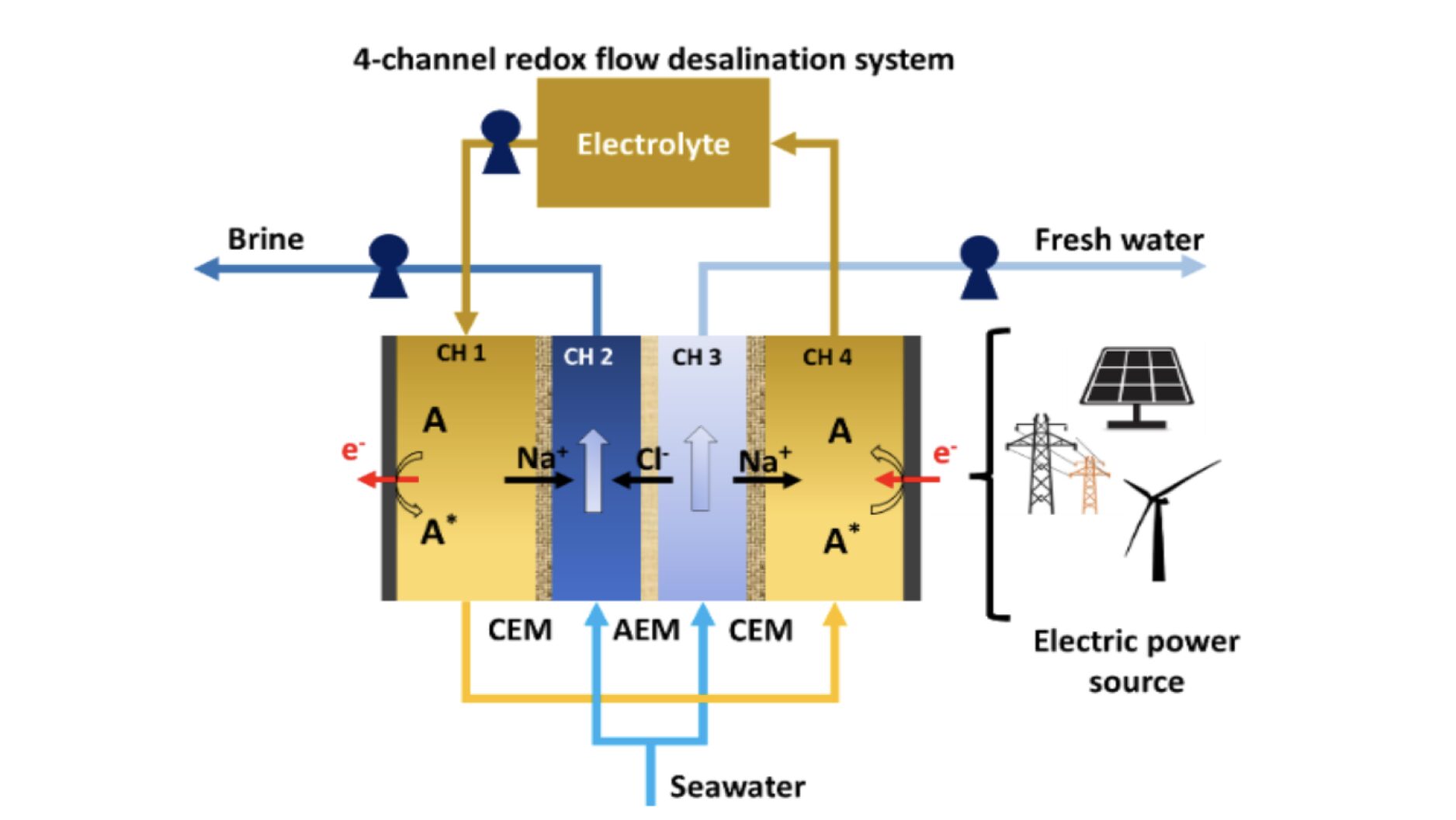
Schematic for a four-channel RFD in single-pass mode with an A/A*, representing electrochemical reactions of redox species dissolved in conducting salts solutions, and channels separated by cation-exchange membrane (CEM) and anion-exchange membrane (AEM).
Water, water everywhere and now we may have drops to drink
Researchers at NYU Tandon School of Engineering achieved a major breakthrough in Redox Flow Desalination (RFD), an emerging electrochemical technique that can turn seawater into potable drinking water and also store affordable renewable energy.
In a paper published in Cell Reports Physical Science, the NYU Tandon team led by Dr. André Taylor, professor of chemical and biomolecular engineering and director of DC-MUSE (Decarbonizing Chemical Manufacturing Using Sustainable Electrification), increased the RFD system’s salt removal rate by approximately 20 percent while lowering its energy demand by optimizing fluid flow rates.
RFD offers multiple benefits. These systems provide a scalable and flexible approach to energy storage, enabling the efficient utilization of intermittent renewable energy sources such as solar and wind. RFD also promises an entirely new solution to the global water crisis.
“By seamlessly integrating energy storage and desalination, our vision is to create a sustainable and efficient solution that not only meets the growing demand for freshwater but also champions environmental conservation and renewable energy integration,” said Taylor.
RFD can both reduce reliance on conventional power grids and also foster the transition towards a carbon-neutral and eco-friendly water desalination process. Furthermore, the integration of redox flow batteries with desalination technologies enhances system efficiency and reliability.
The inherent ability of redox flow batteries to store excess energy during periods of abundance and discharge it during peak demand aligns seamlessly with the fluctuating energy requirements of desalination processes.
“The success of this project is attributed to the ingenuity and perseverance of Stephen Akwei Maclean, the paper’s first author and a NYU Tandon Ph.D. candidate in chemical and biomolecular engineering,” said Taylor. “He demonstrated exceptional skill by designing the system architecture using advanced 3D printing technology available at the NYU Maker Space.”
The intricacies of the system involve the division of incoming seawater into two streams: the salinating stream (Image above, CH 2) and the desalinating stream (Image above, CH 3). Two additional channels house the electrolyte and redox molecule (Image above, A). These channels are effectively separated by either a cation exchange membrane (CEM) or an anion exchange membrane (AEM).
In CH 4, electrons are supplied from the cathode to the redox molecule, extracting Na+ that diffuses from CH 3. The redox molecule and Na+ are then transported to CH 4, where electrons are supplied to the anode from the redox molecules, and Na+ is allowed to diffuse into CH 2. Under this overall potential, Cl- ions move from CH 3 through the AEM to CH 2, forming the concentrated brine stream. Consequently, CH 3 generates the freshwater stream.
“We can control the incoming seawater residence time to produce drinkable water by operating the system in a single pass or batch mode,” said Maclean.
In the reverse operation, where the brine and freshwater are mixed, the stored chemical energy can be converted into renewable electricity. In essence, RFD systems can serve as a unique form of “battery,” capturing excess energy stored from solar and wind sources.
This stored energy can be released on demand, providing a versatile and sustainable supplement to other electricity sources when needed. The dual functionality of the RFD system showcases its potential not only in desalination but also as an innovative contributor to renewable energy solutions.
While further research is warranted, the findings from the NYU Tandon team signal a promising avenue towards a more cost-effective RFD process – a critical advancement in the global quest for increased potable water. As climate change and population growth intensify, more regions grapple with water shortages, underscoring the significance of innovative and efficient desalination methods.
This research aligns seamlessly with the mission of DC-MUSE (Decarbonizing Chemical Manufacturing Using Sustainable Electrification), a collaborative initiative established at NYU Tandon. DC-MUSE is committed to advancing research activities that diminish the environmental impact of chemical processes through the utilization of renewable energy. The current study builds upon Taylor’s extensive body of work in renewable energy, with a recent emphasis on storing sustainably produced energy for utilization during off-peak hours.
Original Article: NYU Tandon researchers unlock energy-efficient solution to global water crisis
More from: NYU Tandon School of Engineering | Shanghai Jiao Tong University
The Latest Updates from Bing News
Go deeper with Bing News on:
Redox Flow Desalination
- About 100 people came to state officials to talk desalination. Here's what they said.
A meeting intended for residents to weigh in on a draft desalination permit drew more than 100 people – and frequent shouting – in an hourslong state-sponsored event Thursday night.
- Contentious TCEQ meeting allows all sides to be heard on seawater desalination
The City of Corpus Christi's Inner Harbor Seawater Desalination Plant was the subject of discussion, specifically their permit to discharge from the desalination process It was a contentious ...
- A desalination plant permit goes to the public again this week. Here's when.
A key element in the city of Corpus Christi’s plans for desalination plant development will go before the public again Thursday in a scheduled meeting on the project’s draft discharge permit. Heading ...
- Barcelona to get floating desalination plant to help fight drought in northeastern Spain
Regional authorities for Spain’s drought-stricken region of Catalonia say they will install a floating desalination plant to help the city of Barcelona guarantee its drinking water supply ...
- Barcelona to get floating desalination plant to help fight drought in northeastern Spain
Find your bookmarks in your Independent Premium section, under my profile Spain’s drought-stricken region of Catalonia will install a floating desalination plant to help the city of Barcelona ...
Go deeper with Bing News on:
Desalination
- Desalination plant behind schedule
A delay in delivery, damage during transit and fouling issues during testing have pushed the desalination plant completion date into 2025.
- MIT Makes Waves with Light-Powered Water Vapor Revelation, Could Change Climate Science and Solar Desalination
MIT researchers discover that light, not just heat, can cause water to evaporate, possibly impacting climate science and drying technologies.
- Desalination, what are the facts?
One thing you can count on is that any project, large or small, will attract an organisation or individuals to protest. It’s a way of life for some people. The project for a desalination plant in ...
- TCEQ hears from opponents and supporters of Corpus Christi desalination plan
People in Corpus Christi could be the first in Texas to drink treated seawater. Water scarcity in the state is a growing crisis, and ocean desalination is being touted as a solution. But community ...
- New Desalination Technology Promises Freshwater Cheaper Than Tap Water
In a world where access to clean drinking water is becoming increasingly scarce, a team of engineers from MIT and Shanghai Jiao Tong University in China have developed a game-changing solution. Their ...










